Key takeaways:
- Community gardens foster connections among neighbors, promoting a sense of belonging and community spirit.
- Engagement in community gardens leads to healthier lifestyle choices and serves as a sanctuary for mindfulness and stress relief.
- Integrating gardens with restaurants enhances the dining experience and supports local agriculture, reinforcing the connection between food and community.
- Creating inclusive and multifunctional spaces within gardens encourages social interactions and strengthens community bonds.
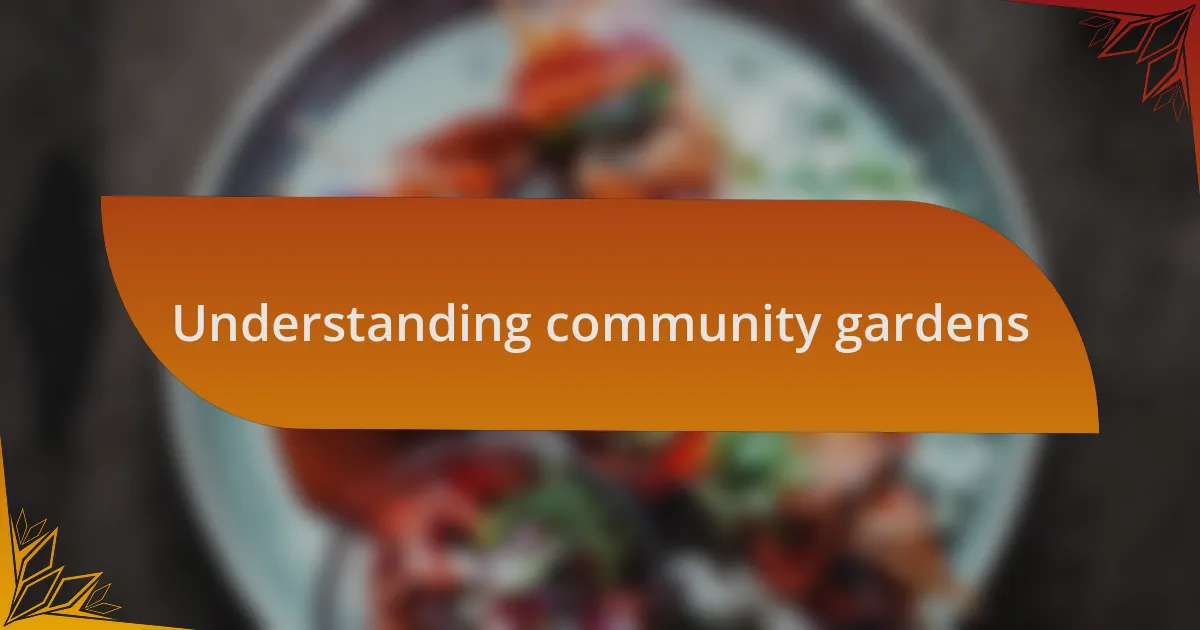
Understanding community gardens
Community gardens represent much more than just a patch of land where flowers and vegetables grow; they are vibrant spaces that foster connections among neighbors. I remember the first time I stepped into a local community garden—there was an undeniable energy in the air, laughter mingling with the earthy scent of freshly turned soil. It struck me then: these gardens are vital hubs where people share not just produce but stories, experiences, and a sense of belonging.
Participating in a community garden can help you feel more connected to your surroundings. I recall a time when our garden struggled with pests, and watching neighbors come together with their unique solutions was inspiring. Who would have thought that sharing different gardening techniques could spark friendships and collaboration? It made me realize that these gardens not only nourish our bodies with fresh food but also cultivate a community spirit.
The benefits of community gardens extend beyond the tangible harvest. Have you ever felt the weight of daily life lift during a moment spent watering plants or chatting with a fellow gardener? I have. This simple practice can serve as a grounding experience, reminding us of the beauty of nature and the joy of working collectively towards a common goal.
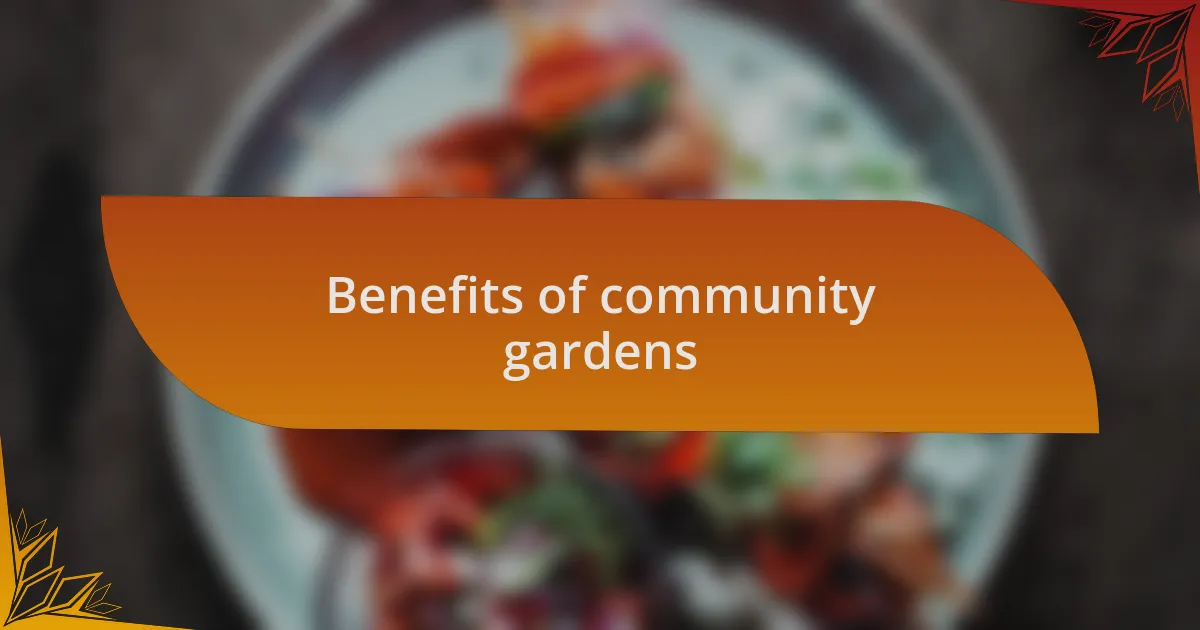
Benefits of community gardens
Engaging with a community garden can lead to a healthier lifestyle. I’ve seen firsthand how sharing tips on growing fresh produce inspires others to adopt healthier eating habits. It was exciting to watch friends who previously reached for takeout start experimenting with the veggies we harvested. Isn’t it amazing how simply growing food can transform our dietary choices and strengthen our resolve to prioritize our wellbeing?
Moreover, community gardens serve as a sanctuary for mindfulness and stress relief. I vividly remember the tranquility of digging my hands into the soil one sunny afternoon, allowing my thoughts to settle while surrounded by greenery. This connection to nature offers a respite that our fast-paced lives often overlook. Have you ever experienced that moment of peace while tending to a garden? It can be remarkably refreshing.
Lastly, community gardens play a significant role in environmental education and sustainability. I was fortunate to attend workshops organized by fellow gardeners, where we learned about composting and organic pest control. These experiences not only enriched my knowledge but also instilled a shared sense of responsibility for protecting our planet. How powerful is it to know that by gardening together, we’re contributing to a more sustainable future? It’s a beautiful reminder of our capacity for positive change.
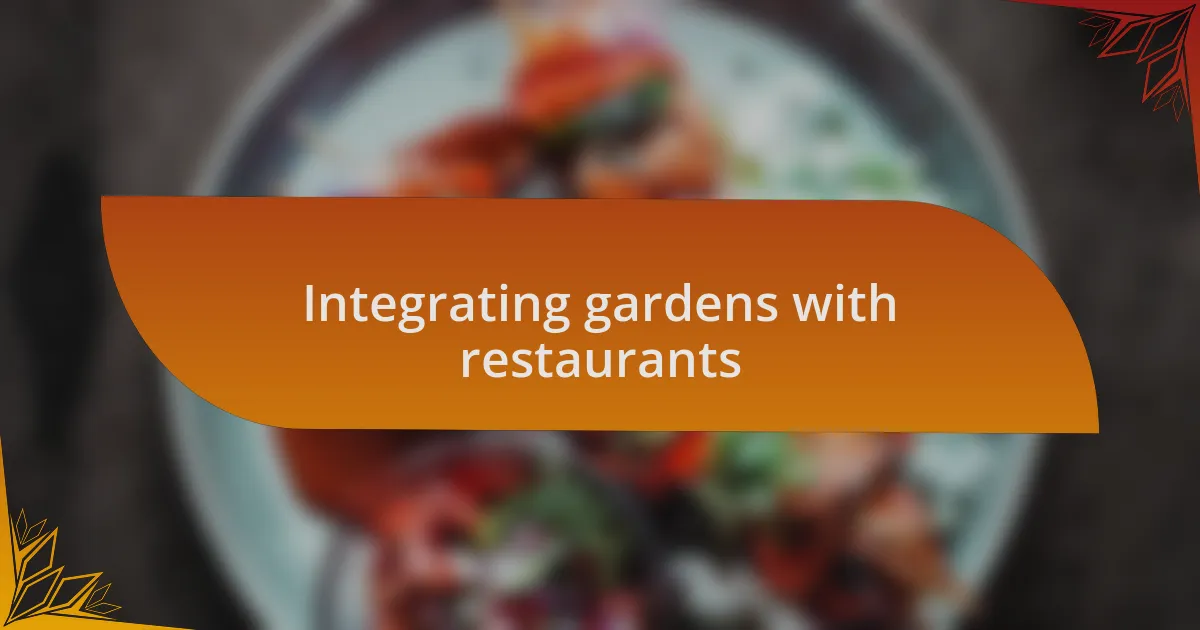
Integrating gardens with restaurants
Integrating gardens with restaurants can create a unique dining experience that is both fresh and sustainable. I recall dining at a restaurant that had its own rooftop garden, where the chef would incorporate ingredients picked just hours before serving. Imagine the flavors and vibrancy of a salad composed of greens harvested that very morning—it was like a burst of life on my plate. Have you ever tasted produce that fresh?
In my own neighborhood, a local eatery partnered with nearby community gardens, sourcing their veggies and herbs directly from the source. It not only supported local growers but also made the menu remarkably dynamic, updating daily based on what was in season. The connection between what they served and the earth was palpable, and it left me pondering: how often do we consider the journey of our food from garden to table?
I’ve found that restaurants with integrated gardens often become community hubs. People gather not only for the delicious meals but also to learn about sustainable practices. I remember attending a cooking demonstration there, where I picked herbs right before they were used in a dish. It felt like a celebration of community, food, and green practices rolled into one delightful experience. Doesn’t it make you think about how we can tighten that bond between what we eat and where it comes from?

Sustainable practices for green restaurants
Sustainable practices for green restaurants extend beyond just sourcing ingredients; they encompass energy efficiency and waste management as well. I once visited a place that went the extra mile by using solar panels to power its kitchen, which made me realize the significant impact restaurants can have on reducing their carbon footprint. Have you ever thought about how the choices of a single restaurant can inspire others to adopt similar eco-friendly measures?
Water conservation is another vital element of sustainability. I remember eating at a bistro that had a rainwater harvesting system in place, using it to water their garden. It left me in awe of how such simple practices can yield not only cost savings but also show a commitment to the environment. It makes me wonder: what if every restaurant embraced such innovative approaches?
Additionally, engaging the community is crucial for truly green restaurant practices. I participated in a farm-to-table dialogue organized by a local restaurant, where chefs and farmers shared their experiences and challenges. It built camaraderie and understanding between diners and producers, making me feel more connected to my food. Isn’t it fascinating how establishing these relationships can create a ripple effect in promoting sustainable practices within our communities?
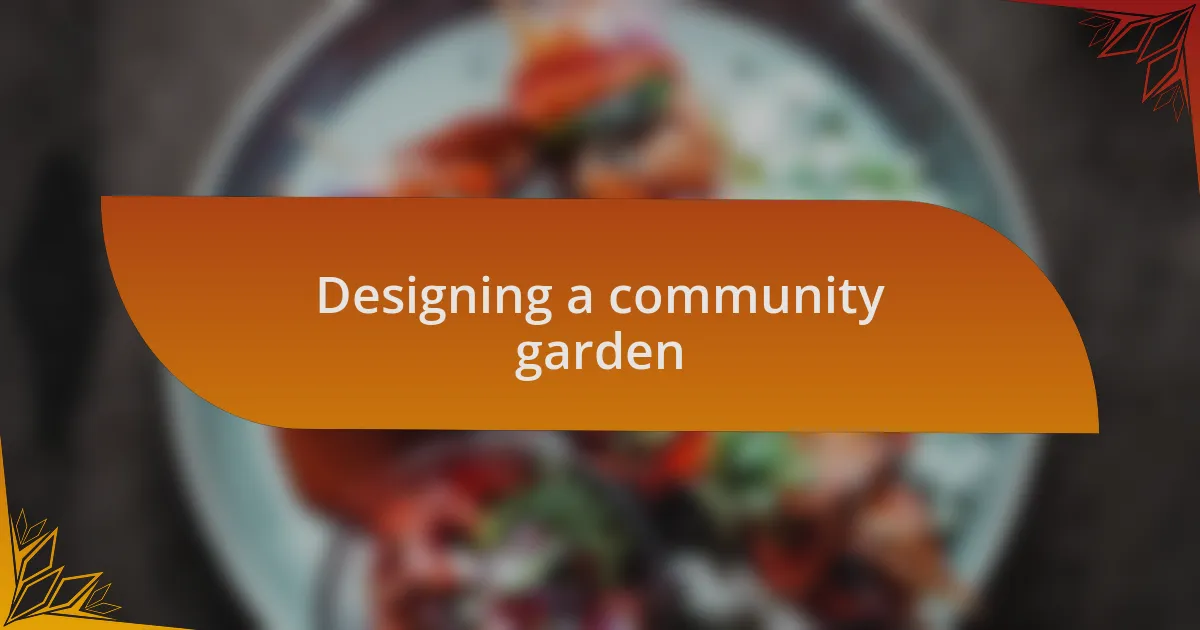
Designing a community garden
When designing a community garden, it’s essential to consider the space’s functionality and accessibility. I remember one community garden that was a blend of raised beds and wheelchair-accessible paths, ensuring everyone could participate, regardless of mobility. Have you ever pondered how inclusivity can enhance a neighborhood’s connection to gardening?
Choosing the right plants is equally important, as they should cater to the local climate and the needs of the community. In one instance, a group of gardeners decided to plant a mix of native species alongside traditional vegetables. This not only provided fresh produce but also attracted pollinators, creating a lively ecosystem. Isn’t it amazing how a diverse plant selection can transform not just the garden, but the entire community dynamic?
Lastly, incorporating communal spaces within the garden can foster social interactions and create a sense of belonging. I found joy in a garden that featured a small gathering area, complete with benches and a fire pit. These spaces encouraged workshops and potluck gatherings, building relationships and making the garden a true community hub. How do you think shared experiences in such environments can inspire people to come together for a common cause?

Personal experiences with community gardens
I have fond memories of my first experience in a community garden. I remember the excitement in the air as strangers became familiar faces; we shared tools, laughter, and stories while planting tomatoes and herbs. It struck me how quickly we formed bonds over the simple act of nurturing the earth together—wasn’t it amazing how a shared purpose can transform strangers into friends?
One summer, I organized a small volunteer day at my local garden, and it was one of the most rewarding experiences I’ve had. We welcomed a diverse group of families and individuals, all eager to learn and contribute. Watching children’s eyes light up as they discovered where their food comes from felt like planting seeds of curiosity and responsibility—how can we cultivate this connection in future generations?
Additionally, I recall a memorable potluck in that garden. Each dish was a story; some brought recipes passed down through generations, while others experimented with new flavors from our garden harvest. It was a beautiful tapestry of culture and creativity—a reminder of how food has the incredible power to unite us. Do you ever reflect on how communal meals can strengthen ties between neighbors and foster a sense of community belonging?
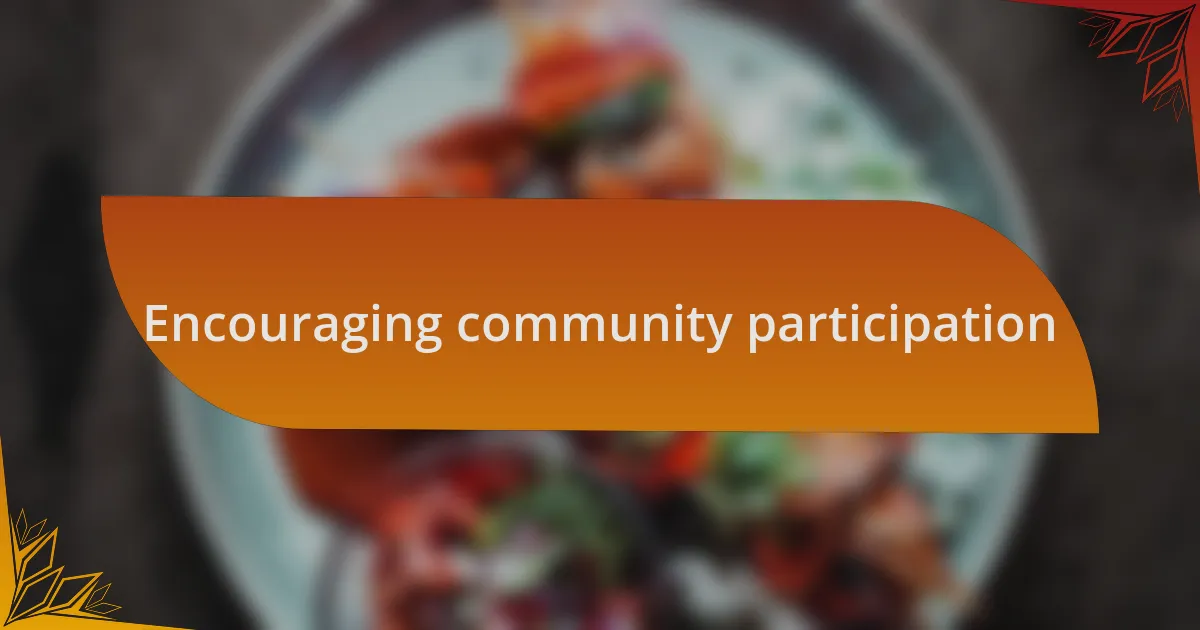
Encouraging community participation
Encouraging community participation in a garden is all about creating spaces where everyone feels welcomed and valued. I vividly remember when we held a “Garden Appreciation Day” to invite our neighbors to join in the fun. The excitement on their faces as they planted their first seedling was infectious—why not create more opportunities like this? It’s through these events that we can remind each other how much joy gardening can bring.
One approach I found particularly effective was organizing themed workshops, like bee-keeping or composting. I’ll never forget the brilliant, animated discussions we had while learning about sustainable practices. People didn’t just come to share their knowledge; they wanted to learn and grow together. Isn’t it fascinating how these gatherings foster a sense of ownership and pride in the garden?
I also made it a point to involve local schools in our community garden initiatives. Partnering with kids and teachers brought fresh energy and ideas. I often witnessed the pure enthusiasm of students as they lined up for garden classes, eager to get their hands dirty. How can we extend this initiative to shape the next generation of environmental stewards? There’s immense potential in nurturing this curiosity and sense of responsibility among young minds.